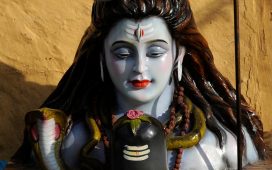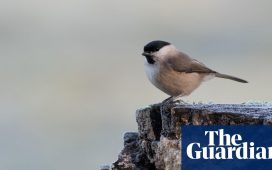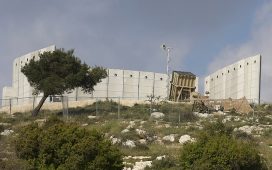
The fires in Brazil have been raging for three weeks.
Carl De Souza / AFP/Getty Images
The Amazon rainforest is burning at a record rate— the highest on record since 2013 and an 83% increase from last year, Reuters reported. Earlier this month, Brazil declared a state of emergency over the rising number of fires in the region. So far this year, almost 73,000 fires in the country have been detected by Brazil’s space research center, INPE.
What caused the fires?
While the Amazon rainforest is typically wet and humid, July and August — the onset of the dry season — are the region’s driest months, with “activity” peaking by early September and stopping by mid-November, according to NASA.
Fire is often used to clear out the land for farming or ranching. For that reason, the vast majority of the fires can be attributed to humans, Christian Poirier, program director of the nonprofit Amazon Watch, told CNN.
Brazil’s president, Jair Bolsonaro, has said publicly that he thinks the fires were set by non-governmental organizations (NGOs) in retaliation to funding cuts. Bolsonaro didn’t provide any evidence for his claims and then later said he never accused any groups, according to the BBC.
What’s the connection to climate change?
In a release Thursday, Greenpeace said that forest fires and climate change operate in a vicious circle. As the number of fires increase, greenhouse gas emissions do too. This makes the planet’s overall temperature rise, the organization said. As the temperature increases, extreme weather events like major droughts happen more often.
“In addition to increasing emissions, deforestation contributes directly to a change in rainfall patterns in the affected region, extending the length of the dry season, further affecting forests, biodiversity, agriculture and human health,” Greenpeace said in the release.
What areas are affected?
Satellite images show fires in the Brazilian states of Amazonas, Rondonia, Para and Mato Grosso. The state of Amazonas is most affected, according to Euronews.
Effects of damage to the Amazon go far beyond Brazil and its neighbors. The area’s rainforest generates more than 20% of the world’s oxygen and is home to 10% of the world’s known biodiversity. The Amazon is referred to as the “lungs of the planet” and plays a major role in regulating the climate. The world would drastically change if the rainforest were to disappear, with impacts on everything from farms to drinking water.
The World Meteorological Organization, the United Nation’s weather arm, tweeted about the fires Thursday.
“Fires release pollutants including particulate matter & toxic gases such as carbon monoxide, nitrogen oxides and non-methane organic compounds into the atmosphere,” the organization said.
How many fires are burning?
In a 48-hour period, leading up to Thursday, there were more than 2,500 active fires in the Brazilian rainforest, the BBC reported Friday.
You can see the smoke from space. The European Union Earth Observation Program’s Sentinel satellites captured images of “significant amounts of smoke” over Amazonas, Rondonia and other areas. NASA has been monitoring the fires. Over the past week, satellites from the EU and NASA have been tweeting images of the smoke on social media.
On Tuesday, Eric Holthaus, a meteorologist, tweeted data showing smoke from the fires covering about half of Brazil. Later in the week, the BBC tweeted a map showing similar data.
The skies blackened over San Paulo, Brazil, for an hour Monday afternoon after a cold front caused winds to shift and carry smoke from about 1,700 miles away. On Friday, Telesur TV reported that smoke from the fires could be seen in Argentina.
Have the fires been put out?
The fires are still active. On Saturday, Amnesty International captured a photo of the burned forests in the Mato Grosso state. Bolsonaro is mobilizing the Brazilian army to combat the flames, Euronews reported.
This is what Bolsnaro’s dismantling environmental + indigenous protections looks like: @amnesty images of fires on indigenous land taken yesterday in Mato Grosso in #Brazil. Before being burned, this forest has been fenced off in preparation for being farmed. pic.twitter.com/L5kJG7WC90
— Richard Pearshouse (@RPearshouse) August 24, 2019
There were reports of scattered rain and thunderstorms on Thursday. It’s unclear whether the rains would help extinguish the fires.
Bolivia’s president, Evo Morales, contracted a Boeing 747 “Supertanker” on Wednesday to help extinguish the fires, Telesur reported. The Supertanker is capable of flying with 115,000 liters (over 30,000 gallons) and was expected to be operational on Friday.
What are politicians doing to help?
President Donald Trump tweeted on Friday that he spoke with Bolsonaro.
“I told him if the United States can help with the Amazon Rainforest fires, we stand ready to assist,” Trump said in his post.
Venezuela President Nicolás Maduro expressed concern about the fires devastating Brazil and Bolivia and offered aid to help extinguish them. The Venezuelan Chancellery also expressed solidarity with the indigenous communities in Brazil, Bolivia, Paraguay, Ecuador and Peru.
“Venezuela expresses its deep concern about the gigantic and terrible fires that devastate the Amazon region in the territory of several South American countries, with very serious impacts on the population, ecosystems and biological diversity of the area,” Venezuela’s Ministry of Popular Power for Foreign Affairs said in a statement to Brasil247 on Friday.
La Pachamama sufre una gran herida con el voraz incendio que consume la Amazonía, además de afectar profundamente a los pueblos originarios que la habitan. Llamo a multiplicar los esfuerzos para preservar la vida en el planeta, solo así, salvaremos a la especie humana. pic.twitter.com/N5oaLOC4hX
— Nicolás Maduro (@NicolasMaduro) August 23, 2019
The Bolivarian Government of Venezuela also proposed a meeting of Foreign Ministers of the Amazon Cooperation Treaty Organization (ACTO) on Friday, posting a letter Venezuelan Foreign Minister Jorge Arreaza.
El Gobierno Bolivariano de Venezuela ha propuesto oficialmente una reunión extraordinaria de Cancilleres de la Organización del Tratado de Cooperación Amazónica (OTCA), para abordar y atender las secuelas ecológicas y sociales de los devastadores incendios en la región amazónica pic.twitter.com/GzQtptOXNh
— Jorge Arreaza M (@jaarreaza) August 23, 2019
Finland’s Prime Minister, Antti Rinne, also released a statement saying that the fires in Brazil were “extremely serious” and that he had contacted the European Commission.
“Brazilian rainforests are vital for the world’s climate. I am truly worried about the attitude Brazil seems to have adopted right now regarding its own forests. Brazil should do all it takes to end the fires that are a danger to our whole civilization,” Rinne said in the statement.
French President Emmanuel Macron tweeted Thursday afternoon with the hashtag #ActForTheAmazon.
“Members of the G7 Summit, let’s discuss this emergency first order in two days!” Macron said in his post. German Chancellor Angela Merkel backed Macron’s call to put the Amazon fires on this weekend’s G7 agenda, the Guardian reported Friday.
Canadian Prime Minister Justin Trudeau retweeted Macron in agreement about bringing attention to the fires at the G7 weekend.
In addition, UK Member of Parliament Rebecca Long-Bailey drafted a letter to Prime Minister Boris Johnson, asking Johnson to tell Bolsonaro that the destruction of the Amazon must stop.
Bolsonaro has faced criticism. People are accusing him of lack of action and of encouraging logging and farming in the Amazon. In early July, an anonymous senior Brazilian official told the BBC that Bolsonaro encouraged deforestation. Ricardo Galvão, the director of the INPE, was fired Aug. 2 after defending data that showed deforestation was 88% higher in June than it was a year ago, CNN reported. In a Facebook video, Galvão announced that he’d been let go by the agency after a meeting with Brazil’s minister of science, technology, innovation and communications, Marcos Pontes.
I have written to the PM with colleagues on the Labour front bench, asking him to tell President Bolsonaro that his destruction of the Amazon must stop, and to introduce tough measures to stop companies in the UK from aiding and abetting tropical deforestation #ActForTheAmazon pic.twitter.com/tFHm7buLul
— Rebecca Long-Bailey (@RLong_Bailey) August 23, 2019
How did the public respond?
#ActForTheAmazon began trending on Twitter and protests began. In Zurich, activists from the Klimastreik Ecological Movement and Brazilians assembled outside of the Brazilian Consulate on Friday morning. In Dublin, the Extinction Rebellion Collective occupied the Brazilian Embassy. Twitter users captured images of a protest in Barcelona as well. Demonstrations have also begun in Paris, London, Madrid and Copenhagen, Denmark.

Members of an indigenous tribe from the Amazon sing during a protest organized by Extinction Rebellion at the Brazilian Embassy in London on Friday.
Mike Kemp/Getty Images
The hashtags #PrayforAmazonas and #AmazonRainforest were trending earlier this week. Twitter users criticized the media for giving more attention to the fire at Notre Dame and other news than to the rainforest fires. Social media users also called out billionaires for lack of donations.
“The Sierra Club has a comprehensive strategy to protect old-growth forests in the US and elsewhere. Specifically in the Amazon, the Club calls on international lenders and institutions to reconsider their investments in Brazil after President Jair Bolsonaro’s reckless exploitation and destruction of a critical resource for the future of humanity,” Javier Sierra, the Sierra Club’s associate director of communications for Latino media, said in an email.
Sierra pointed out that both Norway and Germany have already said they would cease to provide funds for the Amazon’s preservation until Bolsonaro reverses course.
“Those who destroy the Amazon and let deforestation continue unabated are encouraged in doing so by the Bolsonaro government’s actions and policies. Since taking office, the current government has been systematically dismantling Brazil’s environmental policy,” Danicley Aguiar of Greenpeace Brazil said in a release Thursday.
The World Wildlife Fund’s European policy office released a statement Thursday as well.
“Faced with this ecological devastation, WWF calls on the countries of the region — Brazil, Bolivia, Colombia, Peru, Ecuador, Venezuela, Guyana and Suriname — to protect the Amazon, fight deforestation and reduce the causes behind these fires. It also calls on the EU and its Member States to step up its efforts to curb the impact of EU consumption on deforestation and the destruction of other ecosystems around the world, linked to commodities such as soy, palm oil, cocoa or meat.”
In addition, actor and environmentalist Leonardo DiCaprio added a donation link to Amazon Watch on his Instagram profile and posted about the fires. Celebrities like Jameela Jamil, Jaden Smith and John Cusack have also taken to social media to speak out about the fiery devastation.
How can you help?
Here are some ways you can aid in protecting the rainforest:
- Donate to Rainforest Action Network to protect an acre of the Amazonian rainforest.
- Donate to the Rainforest Trust to help buy land in the rainforest. Since 1988, the organization has saved over 23 million acres.
- Reduce your paper and wood consumption. Double-check with Rainforest Alliance that what you’re buying is considered rainforest-safe. You can also purchase rainforest-safe products from the alliance’s site.
- Reduce your beef intake. Beef found in processed products and fast-food burgers is often linked to deforestation.
- The World Wide Fund for Nature (known as the World Wildlife Fund in the US and Canada) works to protect the species in the Amazon and around the world.
- Ecosia.org is a search engine that plants a tree for every 45 searches you run.
- Explore Change.org petitions. A lawyer in Rio Branco has accumulated over 3 million signatures to mobilize an investigation into the Amazonian fires.
- Donate to Amazon Watch, an organization that protects the rainforest, defends Indigenous rights and works to address climate change.
- Donate to the Amazon Conservation Team, which works to fight climate change, protect the Amazon and empower Indigenous peoples.
- Amazon Conservation accepts donations and lists exactly what your money goes toward. You can help plant trees, sponsor education, protect habitats, buy a solar panel, preserve Indigenous lands and more.
- Contact your elected officials and make your voice heard.
- Donate to One Tree Planted, which works to stop deforestation around the world and in the Amazon Rainforest. One Tree Planted will keep you updated on the Peru Project and the impact your trees are having on the community.
- Sign Greenpeace’s petition telling the Brazilian government to save the Amazon rainforest and protect the lands of indigenous and traditional communities.
Originally published Aug. 21, 2019.
Updates, Aug. 22 and Aug. 23: Adds more background and adds statements from Greenpeace, WWF EU and Sierra Club. Updates Aug. 24: Adds more background. Aug 25 update.








